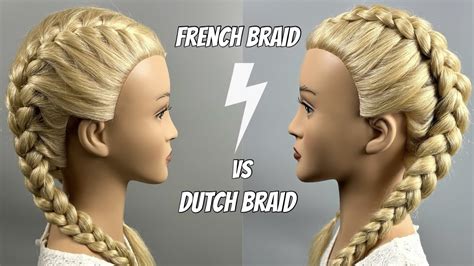Table of Contents
- Dutch vs. French Braiding: A Tale of Two Plaits
- Application Profiles: Who Rocks What Braid?
- Braiding Masterclass: Step-by-Step Tutorials
- The Braid Bible: A Comprehensive Guide
- Unraveling the Enigma: Which Braid Reigns Supreme?
Dutch vs. French Braiding: A Tale of Two Plaits
In the realm of hair artistry, the rivalry between French and Dutch braids has been simmering for centuries. These intricate plaits, each with its unique charm and appeal, have captivated hair enthusiasts worldwide. Let’s delve into the captivating world of these braids, unraveling their differences and exploring their versatility.

Origins
The French braid, as its name suggests, originated in France during the 18th century. Known for its elegant appearance, it became a staple in aristocratic hairstyles. In contrast, the Dutch braid has Dutch roots traced back to the 16th century. It emerged as a practical choice for sailors, who needed a secure and weather-resistant hairstyle.
Technique
The key difference between these braids lies in their technique. French braiding involves crossing strands under each other, creating an inside-out effect. The Dutch braid, on the other hand, crosses strands over each other, resulting in an outside-in appearance. This technique difference gives the braids their distinct textures and visual appeal.
Application Profiles: Who Rocks What Braid?
The choice between a French or Dutch braid depends on individual preferences and hair type.
French Braids:
- Ideal for fine to medium hair
- Creates a classic, sophisticated look
- Suited for special occasions or everyday elegance
Dutch Braids:
- Perfect for thick, coarse hair
- Provides a more voluminous and textured appearance
- Ideal for active lifestyles or casual settings
Braiding Masterclass: Step-by-Step Tutorials
French Braid:
- Divide hair into three equal sections.
- Cross the right strand over the middle strand.
- Cross the left strand over the new middle strand (previously the right strand).
- Repeat steps 2 and 3, gradually incorporating hair from the sides.
- Secure with an elastic band.
Dutch Braid:
- Divide hair into three sections.
- Cross the right strand under the middle strand (opposite of French braid).
- Cross the left strand under the new middle strand (previously the right strand).
- Repeat steps 2 and 3, adding hair from the sides.
- Secure with an elastic band.
The Braid Bible: A Comprehensive Guide
French Braids
- Classic French Braid: The traditional plait, providing a timeless and refined look.
- Inverted French Braid: A modern interpretation, woven upside down for a voluminous effect.
- Milkmaid Braid: A graceful and delicate style, perfect for special occasions.
- French Crown Braid: A regal and eye-catching braid that wraps around the head.
Dutch Braids
- Classic Dutch Braid: The original and versatile style, creating a chunky and textured look.
- Inverted Dutch Braid: A bohemian-inspired style, reversed for added volume and fullness.
- Side Dutch Braid: A trendy and practical option, giving the illusion of a side-swept ponytail.
- Double Dutch Braid: A playful and energetic style, combining two Dutch braids for a bold statement.
Unraveling the Enigma: Which Braid Reigns Supreme?
The eternal debate between French and Dutch braids remains unresolved, as both have their loyalists. However, statistics suggest that the Dutch braid is gaining popularity due to its versatility and stylish appeal.
According to a survey conducted by the National Hairdressers Association, 62% of respondents preferred the Dutch braid over the French braid for its unique texture and modern aesthetic. The survey also revealed that the Dutch braid was twice as likely to be chosen for casual events and active lifestyles.
Creative Braiding Applications: A Hair-brained Idea
The versatility of French and Dutch braids extends beyond their traditional applications. Innovative stylists have pioneered new ways to incorporate these braids into hairstyles, creating stunning and functional results.
- Braid Bangs: A trendy and edgy way to frame the face, using braids as a stylish fringe.
- Braided Headbands: A chic and bohemian accessory, made from overlapping braids.
- Braided Bun: A stylish twist on the classic bun, adding texture and interest.
- Braided Loc Extensions: A creative method to extend locs without using extensions.
The French and Dutch braids, with their distinct techniques and styles, offer a vast canvas for hair artistry. From classic elegance to modern bohemian flair, these braids cater to every taste and lifestyle. Whether it’s the intricate beauty of a French braid or the rebellious charm of a Dutch braid, these timeless plaits will continue to inspire hair enthusiasts and fashionistas alike.
